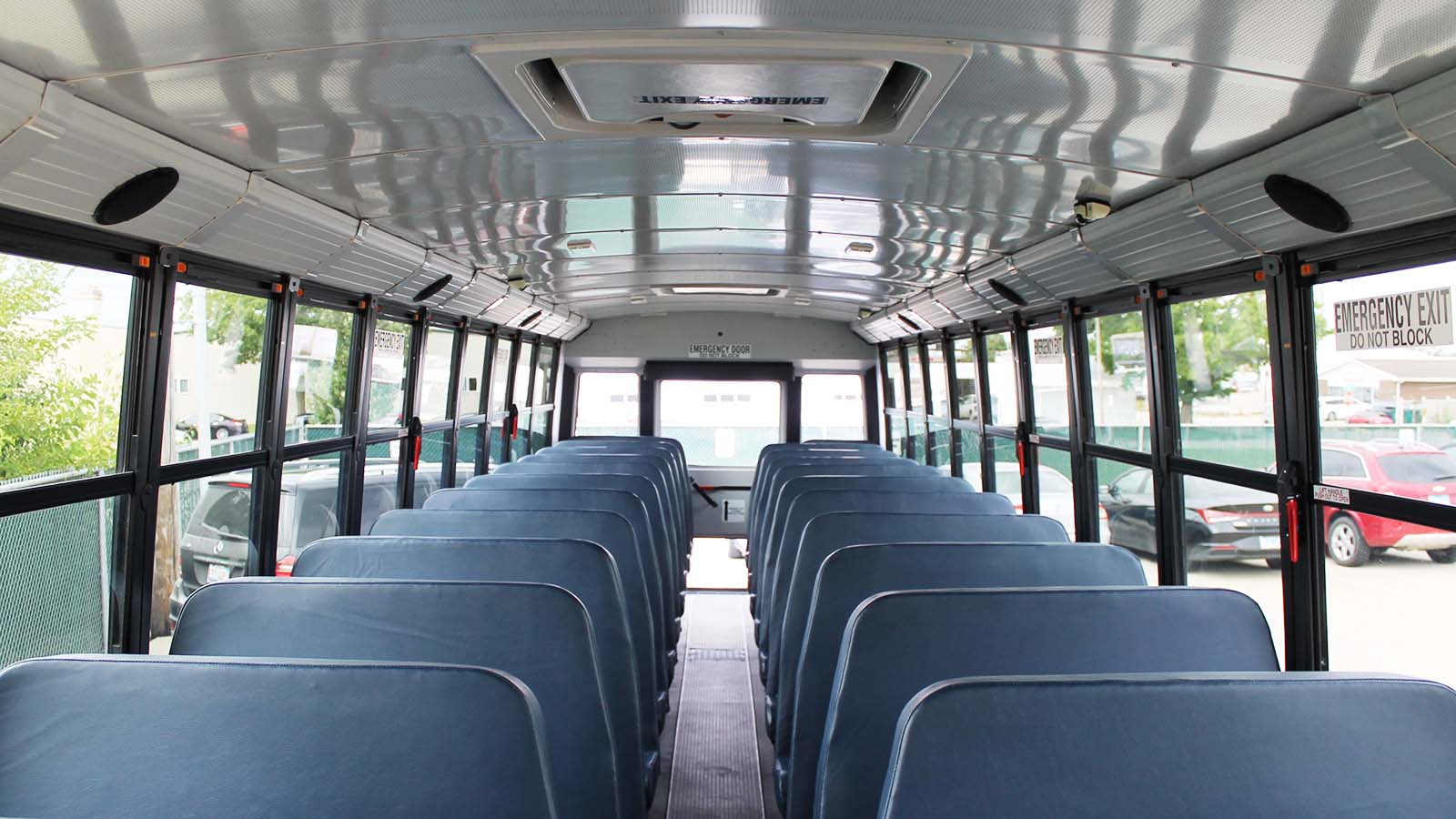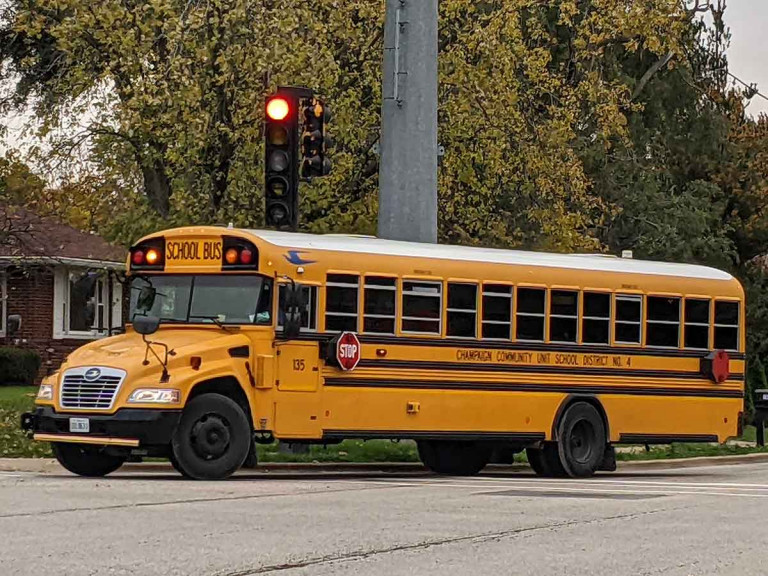School buses are among the safest forms of transportation for children, and seat belts and other safety features can make buses even safer, according to the National Safety Council. But very few states currently have laws requiring seat belts on large school buses.
Only eight states – Arkansas, California, Florida, Louisiana, Nevada, New Jersey, New York and Texas – have such laws, according to the National Conference of State Legislatures. Iowa adopted a rule requiring lap-shoulder belts on all new school buses starting in 2019.
During a recent visit to Champaign, U.S. Sen. Tammy Duckworth (D-IL) announced the reintroduction of the School Bus Safety Act.
The federal bill calls on the U.S. Department of Transportation to set national standards for school bus safety and specifically advocates for the addition of three-point seat belts that cross the shoulder and lap.

“Any fatality or serious injury is one too many when we have proven affordable technologies available today that could prevent such a tragedy,” Duckworth said during her visit.
Duckworth has been advocating for seat belts on school buses for several years. She introduced the School Bus Safety Act In 2019, but it stalled in committee. The 2023 legislation was assigned to a committee after it was introduced in September. No further action has been taken.
Seat belts would make school buses even safer
While seat belts on every school bus would make them safer, it’s important to note that school buses — with or without seat belts — are already the safest vehicles on the road, according to Kristin Poland, the deputy director of the Office of Highway Safety at the National Transportation Safety Board (NTSB) and an expert in school bus safety.
Poland, who has studied school bus crashes for almost 25 years, said riding on a school bus without a seat belt is even safer than riding in a car with a seat belt..
“School buses are incredibly safe for a number of reasons,” Poland said. “Some of that is because of state laws that require school buses to be bright yellow, have flashing lights on them and dictate how other vehicles must operate around a school bus.”
She said there are also federal standards for the construction of school buses, regulating the strength of the roof and side rails so school buses are less likely to collapse after a collision.
If a crash does occur, occupants are protected by the seatbacks in front of them, a phenomenon known as compartmentalization. The closely spaced seats, she said, are designed to absorb energy during a crash.
“In a frontal crash, an occupant will slide forward and quickly interact with that seatback in front,” Poland said. “They distribute the force over a large area, including their knees, their chest, their head, and the seatback deforms to almost cradle them within that seat compartment.”
Compartmentalization, however, doesn’t have the same benefits in side-impact crashes or high-speed rollover crashes, which Poland notes are far more rare than front-impact crashes. In those instances, the data suggests a seat belt that crosses over both the child’s lap and shoulder could save lives.
“The best outcome we were seeing for all crash types was a lap-shoulder belt combined with the inherent design of compartmentalization,” Poland said.
For years, NTSB has maintained that seat belts are statistically safer for students riding buses to school.
To Duckworth, three-point, lap-shoulder belts are a necessary addition to large school buses.
“The school bus is still the safest way for your children and mine to get to school,” Duckworth said. “But we still see fatalities and injuries on school buses, many of which could have been prevented.”
National data shows 206 school-aged children died in school-transportation-related crashes from 2012 to 2021. Of those, 42 were passengers of school transportation vehicles, like school buses, according to the National Highway Transportation Safety Administration (NHTSA).
Small school buses, with a gross vehicle weight rating of 10,000 pounds or less, are already required to have lap or lap-shoulder belts at all designated seating positions, according to NHTSA, since the sizes and weights of small school buses are closer to those of passenger cars and trucks.
But Illinois — and the vast majority of other states — do not currently have laws mandating seat belts on large school buses.
A seat belt mandate would come at a high cost
Many states are hesitant to require school bus seat belts by law due to the financial burden. According to the NCSL, the cost of seat-belt installation ranges from about $7,000 to $10,000 per vehicle.
While acknowledging the added safety of seat belts on school buses, NHTSA maintains that states and school districts considering seat belts on large school buses should carefully consider the ripple effects and impacts on school transportation safety overall — including possible unintended consequences.
In an email, a spokesperson for NHTSA said the organization has reservations about school bus seat belt laws because the cost of seat belt installation could decrease the number of school buses available for students.
As a result, students would have to find another way to get to school, such as car riding, which would be less safe.
Additionally, NHTSA has cited concerns that the bill may result in tradeoffs with other child-safety initiatives that are known to improve outcomes in significant ways.

Children are at greatest risk of danger when entering or exiting a school bus, according to NHTSA’s 2012-2021 report on school bus safety. Between 2012 and 2021, there were 183 fatalities among pedestrians in school-transportation-related crashes — that’s 1.6 times more than fatalities among occupants of school-transportation vehicles in such crashes, NHTSA found.
The organization has maintained this position for years. In a 2015 public meeting, the organization cited a 2010 study from the University of Alabama that found the benefit of seat belts on school buses led to eight injuries avoided annually and the equivalent of one life saved every decade.
“Since school buses are already very safe, the added benefit of seat belts on large school buses is small relative to other potential safety measures such as improvements in the safety of child pedestrians as they enter or exit the bus,” NHTSA said in a statement.
Without federal funding, school bus upgrades in Illinois could be ‘cost-prohibitive’
The Illinois State Board of Education (ISBE) said in an email that many school districts lack the funding to install seat belts on all school buses.
“We wholeheartedly support protecting student safety on buses,” said Jaclyn Matthews, ISBE’s chief communications officer. “However, without additional federal funding to implement the mandate, this requirement couldbe cost-prohibitive for some school districts.”
Duckworth recognized this financial concern in her visit to Unit 4 in September and said the bill will include a grant program to help school districts modify school buses to meet safety requirements.
“We have to be fiscally conservative, we have to marshal our resources, there are places where we can cut spending,” she said. “But there are things that we’re gonna have to spend money on. And I think protecting our children is one of those places.”
Duckworth’s office did not respond to questions seeking additional information about the bill’s financing. It remains unclear how much money would be available to schools to pay for school bus upgrades if the School Bus Safety Act becomes law.
The 2023 School Bus Safety Act is supported by the National Safety Council, Advocates for Highway and Auto Safety, Center for Auto Safety, National Sheriffs’ Association, American Academy of Pediatrics, National Parent Teacher Association, and Consumer Reports.

